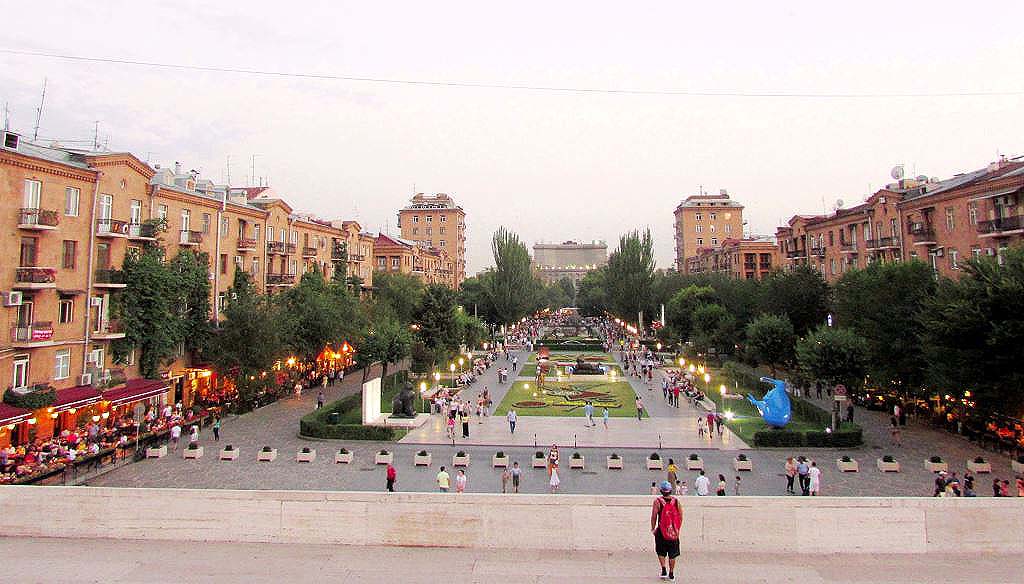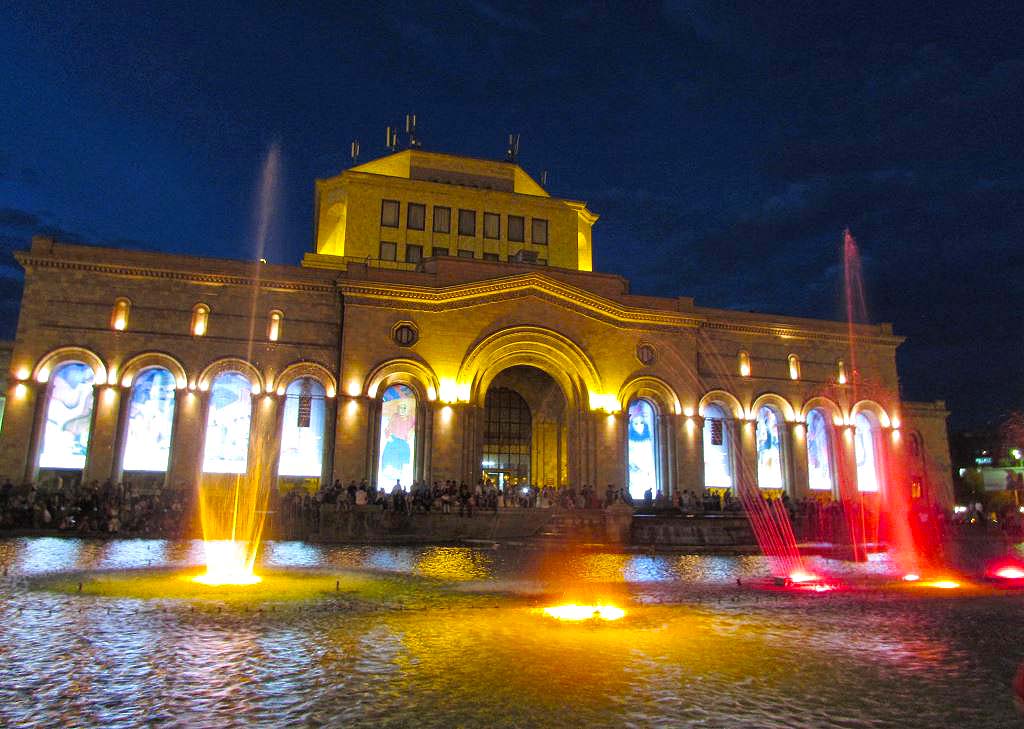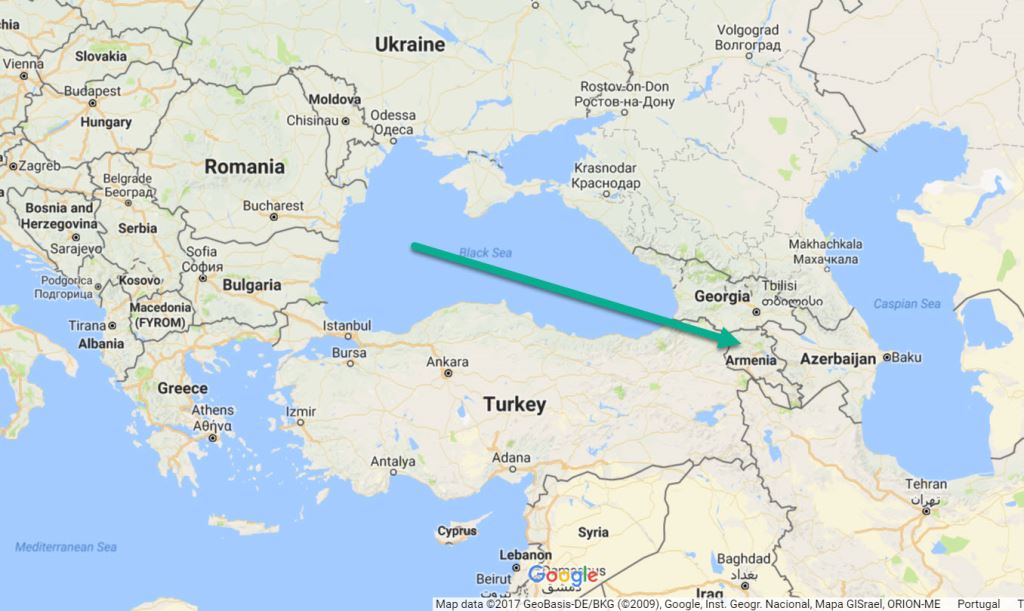“I was born and raised in X city” … This is how the stories about ones native town usually begin… Well, the truth is that I was not born in Yerevan, but I am hundred percent Armenian and spent most of my life in Yerevan. Hence, naturally Yerevan is my Native town.
 Yerevan city view with magestic Ararat mountain in the background.
Yerevan city view with magestic Ararat mountain in the background.
My story begins with the name of my country, "Armenia" that is oftentimes confused with the European country Romania. Whenever I would travel abroad and people would ask me, “Where do you come from?” I periodically received the same reaction: “Ah, Romania!”. “Not Romania, but Armenia”, I would respond. “Oh, the tiny country in Caucasus?”, - and the story would go on.
This repeating reaction made me think there is something wrong with my pronunciation. But then I learned that other Armenians faced the same reality, too. Of course, Romania is bigger and it is a European Union country, hence more popular than Armenia. People do know where Romania is situated, but quite a large portion of foreigners are simply unaware of Armenia’s location. Consequently, following the above mentioned question, they are usually asking: “So where is Armenia located?”. And I start explaining the map and specifying the concrete whereabouts of my country.
So, let me draw the line: Armenia is a small Caucasian country neighbouring with Georgia, Iran and Turkey [See Map]. According to official sources, Armenia is the first country to have adopted Christianity as a state religion, an ancient country that roots back to the pre-Christian times. We- Armenians do have our own language, which is Armenian - a separate branch of Indo-European language family. The present capital of Armenia is Yerevan- the thirteenth capital in the history of Armenia.
This article will shed a light on Yerevan from a “local” traveller’s perspective and will explore the highest peak of Armenia - the gracious Mount Aragats.
 Yerevan is where the sun accentuates the pinkish allure of the buildings… Yerevan is where a quaint gorge of Hrazdan River splits up the city into two separate parts. Yerevan is where my heart is…
Yerevan is where the sun accentuates the pinkish allure of the buildings… Yerevan is where a quaint gorge of Hrazdan River splits up the city into two separate parts. Yerevan is where my heart is…
When visiting Armenia, formerly travellers would be somehow sceptical on how they were going to interact with locals. But those times are way in the past. Nowadays, you can meet lots of Armenians in the capital who may explain you directions or give you a lovely advice in clear and fluent English. Furthermore, Yerevan and Armenia are so alluring for visitors due to the warm hospitality of Armenians and their genuine will to help foreigners. On the other side, there is the food factor- one of the greatest delights of life and which is simply delicious in Armenia. All these aspects will certainly facilitate your stay in Yerevan and make you feel contented wholeheartedly.
Yerevan is centrally located, providing good connections to the different regions of Armenia. While being an ancient city (which is older than the capital Rome), Yerevan continues to modernise by constructing new buildings and creating pedestrian streets like the modern Northern Avenue. It is worth noting that previously, the city did not possess streets with no car traffic, designed especially for walking. Therefore, the creation of Northern Avenue is something innovative in its type. You may have wonder why Yerevan is called a pink city? Well, that is because of the pink tuff prevailing in the buildings of Armenian capital; an exquisite distinguishing sign of Yerevan.
Hereby, I will showcase some ways on how to explore Yerevan through the eyes of a traveller (suggested by a local), and how you can spend your precious time in my beloved Yerevan.
Things to do in Yerevan
Climb up the impressive Cascade Hills- a beautiful marble stairway in the centre of Yerevan, showcasing a unique piece of architecture. (Remark: if you would like to watch spectacular scenery escorted by evening lights, go to Cascade during the evening or a night time. This is something worth seeing!). However, if you wish to witness the majestic Ararat from Cascade, pick up a day and time with a clear-blue sky.
 Cascade Yerevan ziggurat terraces and gardens.
Cascade Yerevan ziggurat terraces and gardens.
When in doubt, go to the Statue of Alexander Tamanyan in Cascade and observe the statue from upside down. Later on, walk around the statue to spot the modern sculptures posing in front of Cascade: a cat, a fat smoking woman and others are there to surprise you. Whether you will be admired or shocked in a positive way let it be a guess to be uncovered during your travel in Yerevan. Continue your way to the mesmerising Swan Lake, which is just in front of the Opera House in Yerevan. This site of interest is barely under crowded; hence it is a good idea to watch the beauty of the lake when the stars in the clear-night sky and the city lights illuminate the water.
For artistic souls, a very special museum of Yervand Kochar is awaiting you there to be valued. Yervand Kochar was a talented Armenian painter and sculptor; he was the creator of Painting in Space or “Peinture dans L’espace”. To continue feeding your artistic lust, walk along the way to reach Cafesjian Museum of Art and National Gallery of Armenia. If you would like to see appealing art works of local painters, you may do so in an open-air exhibition market in the lovely park named after Martiros Saryan- a great Armenian painter. From there on, there is a short walk to one of the most important sites in Yerevan- Matenadaran, a museum where a huge collection of ancient manuscripts are preserved.
Dive into the history of early civilizations with a visit to the History Museum of Armenia. This site houses a large collection of items presenting Armenian Highlands from different periods- Bronze Age, prehistoric, Urartian, Hellenistic and present times.
When visiting Yerevan in summer, enjoy a beautiful evening watching the delightful singing Fountains on Republic Square, presenting an exciting play of colour and sounds; this could be a cheerful ending of your day full of activities. This is how I usually do when walking through the streets of Yerevan.
 The History Museum of Armenia and the National Gallery of Armenia.
The History Museum of Armenia and the National Gallery of Armenia.
In the wake of the origin of Yerevan city, visiting Erebuni Fortress is of special importance: this is the birthplace of Yerevan, a site where Armenians celebrate annual celebrations devoted to our sunny capital.
And for sure, your trip would not be complete without visiting the Republic Square: exposing magnificent architecture, designed by the architect Alexander Tamanyan. Perhaps it is somehow a subjective view, but from all those cities (over forty one) and squares I have witnessed, the Republic Square in Yerevan is much more attractive compared to a list of European squares. I may not say that it is the best and most impressive square in the world, but the architectural grace and the whole splendid scenery it reflects, is something really peculiar to witness. Every time I walk around the Republic Square, I discover new elements that were unseen before: the ornaments on the exterior of the buildings, explicit works of art and architecture are all signs of a thoroughly sketched plan that leave you endlessly admired.
This was Yerevan… But Armenia does not start or end only with Yerevan. Our small country is filled with so much to be seen for each and every taste: historical sites, beautiful natural landscapes, marvels of culture and the list goes on.
 Lake near Mount Aragats. Photo by Roland Yeghiazaryan on Unsplash
Lake near Mount Aragats. Photo by Roland Yeghiazaryan on Unsplash
Mount Aragats, the Highest Peak in Modern Armenia
For climbers out there, Armenia offers plenty of opportunities. You may have heard that Armenia is pretty much synonymised with the name “Stone country” or “Mountainous country”. That is because our country is occupied by mountains and hills. Nestled in Aragatsotn province of Armenia and less than fifty kilometres away from the capital Yerevan, Mount Aragats is the highest peak of the country- 4090 km above the sea level. It is quite impressive to have the chance visiting such a high peak located so close to the capital. The imposing Mount Aragats has four summits to be conquered, of which the Northern side is the hardest one to be reached (according to experienced climbers). Even in the summertime, Aragats is covered by snow. So if you feel a sense of nostalgia for a pure white snow, this is a place to be. However, Aragats is not alone. On the slopes of the mountain, you will find a Lake called Kari- recreation site for many Armenians. When visiting this area in summer, be careful under the sun in order not to get sunburned.
 Armenia map.
Armenia map.